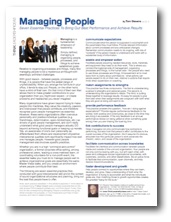Essential Practices for Managing People
Managing People... overview coaching session
click the image below to hear this week’s coaching session
7 Ideas Coach is a weekly series of coaching sessions,
7 nuggets of insight in 7 minutes for busy leaders
Get 7 Ideas Coach each week via email or through Apple iTunes
 THINK! Subscribers Receive the PDF Version FREE
THINK! Subscribers Receive the PDF Version FREE
7 Essential Practices to Bring Out Best Performance and Achieve Results
Managing is a fundamental dimension of leadership. Simply defined, managing is organizing people, processes, and things to achieve established goals. Relative to organizing processes and things, many find managing people to be a mysterious art fraught with seemingly unlimited challenges.
With good reason - between people, processes and things, it is people that have the widest range of unpredictability. When you arrange the furniture in your office, it tends to stay put. People, on the other hand, have a mind of their own. It’s that mind of their own that allows them to make greater contributions to your organization than you might ever expect - or create problems and headaches you never imagined.
Many organizations have grown beyond trying to make people into machines, they value the creativity, passion, and brainpower that people contribute, and therefore recognize good people management as essential. However, these same organizations often overvalue personality and positive individual qualities (e.g. friendliness, determination, open-mindedness, etc.) as drivers of good people management, and don’t really understand what good people managers actually DO beyond achieving functional goals or keeping up morale. Yes, an awareness of one’s own personality as differentiated from others and development of positive interpersonal qualities both significantly impact how well one manages people. However good people management also involves specific practices.
Whether you are in a high “command-and-control” organization, a formal corporate office setting, among professional peers, leading a cross-matrixed team, or coordinating volunteers for a non-profit event, the essential tasks you must do to manage people well to achieve organizational goals are essentially the same. Master these tasks, and you create an environment where people contribute their best.
The following are seven essential practices that, conducted with good interpersonal skill and in the context of sound organizational structures and planning, bring out the best that people have to offer.
communicate expectations
Communicate what the person is supposed to accomplish and the parameters they must follow. Provide relevant information about current processes and any anticipated changes. Remember communication needs to be ongoing, with lots of “contacts” if the person needs to understand and work with a substantial body of information.
enable and empower action
Facilitate people acquiring needed resources, tools, materials, and equipment they need to do their work. This is where you connect the logistical side of management, organizing processes and things, to the human side - the people who need to use those processes and things. Empowerment at its most basic form is clarity about permissions - what actions can people expect to do on their own, relative to actions that require more direct supervision or coaching.
match assignments to strengths
This practice has three components. The first is understanding a person’s strengths and personal goals. The second, is understanding the organization’s needs. The third, is putting these together to leverage results. It’s easy for people to give their best when their assignments are congruent with both what they are good at doing and want to do.
provide performance feedback
This practice answers the question, “how am I doing against expectations?” Provide regular performance feedback to the worker, both positive and constructive, as close to the time they are doing it as possible. If the only feedback is an annual performance review (or being yelled at when something goes wrong) then you are missing the boat big time.
link contributions to success
Great managers not only communicate how someone is performing, but also how that person’s effort contributes to the overall success of the organization. Don’t assume it’s obvious, articulate how this particular person’s work advances the mission, vision, and cause of the organization.
facilitate communication across boundaries
Facilitate the interface and communication between people inside and outside of the unit and organization. Your people are not only communicating with you, but with each other, with peers and colleagues across organizational boundaries, with customers, vendors, and other stakeholders. Be an active force to facilitate that communication, open channels, and help resolve miscommunications.
foster development and growth
Help people connect to opportunities where they can learn, develop, and grow. Deep understanding of both what the organization is trying to accomplish and what the individuals goals are, then matching those to growth opportunities creates the greatest “bang for the buck.”
click the image below to hear this week’s coaching session
7 Ideas Coach is a weekly series of coaching sessions,
7 nuggets of insight in 7 minutes for busy leaders
Get 7 Ideas Coach each week via email or through Apple iTunes
 THINK! Subscribers Receive the PDF Version FREE
THINK! Subscribers Receive the PDF Version FREE7 Essential Practices to Bring Out Best Performance and Achieve Results
Managing is a fundamental dimension of leadership. Simply defined, managing is organizing people, processes, and things to achieve established goals. Relative to organizing processes and things, many find managing people to be a mysterious art fraught with seemingly unlimited challenges.
With good reason - between people, processes and things, it is people that have the widest range of unpredictability. When you arrange the furniture in your office, it tends to stay put. People, on the other hand, have a mind of their own. It’s that mind of their own that allows them to make greater contributions to your organization than you might ever expect - or create problems and headaches you never imagined.
Many organizations have grown beyond trying to make people into machines, they value the creativity, passion, and brainpower that people contribute, and therefore recognize good people management as essential. However, these same organizations often overvalue personality and positive individual qualities (e.g. friendliness, determination, open-mindedness, etc.) as drivers of good people management, and don’t really understand what good people managers actually DO beyond achieving functional goals or keeping up morale. Yes, an awareness of one’s own personality as differentiated from others and development of positive interpersonal qualities both significantly impact how well one manages people. However good people management also involves specific practices.
Whether you are in a high “command-and-control” organization, a formal corporate office setting, among professional peers, leading a cross-matrixed team, or coordinating volunteers for a non-profit event, the essential tasks you must do to manage people well to achieve organizational goals are essentially the same. Master these tasks, and you create an environment where people contribute their best.
The following are seven essential practices that, conducted with good interpersonal skill and in the context of sound organizational structures and planning, bring out the best that people have to offer.
communicate expectations
Communicate what the person is supposed to accomplish and the parameters they must follow. Provide relevant information about current processes and any anticipated changes. Remember communication needs to be ongoing, with lots of “contacts” if the person needs to understand and work with a substantial body of information.
enable and empower action
Facilitate people acquiring needed resources, tools, materials, and equipment they need to do their work. This is where you connect the logistical side of management, organizing processes and things, to the human side - the people who need to use those processes and things. Empowerment at its most basic form is clarity about permissions - what actions can people expect to do on their own, relative to actions that require more direct supervision or coaching.
match assignments to strengths
This practice has three components. The first is understanding a person’s strengths and personal goals. The second, is understanding the organization’s needs. The third, is putting these together to leverage results. It’s easy for people to give their best when their assignments are congruent with both what they are good at doing and want to do.
provide performance feedback
This practice answers the question, “how am I doing against expectations?” Provide regular performance feedback to the worker, both positive and constructive, as close to the time they are doing it as possible. If the only feedback is an annual performance review (or being yelled at when something goes wrong) then you are missing the boat big time.
link contributions to success
Great managers not only communicate how someone is performing, but also how that person’s effort contributes to the overall success of the organization. Don’t assume it’s obvious, articulate how this particular person’s work advances the mission, vision, and cause of the organization.
facilitate communication across boundaries
Facilitate the interface and communication between people inside and outside of the unit and organization. Your people are not only communicating with you, but with each other, with peers and colleagues across organizational boundaries, with customers, vendors, and other stakeholders. Be an active force to facilitate that communication, open channels, and help resolve miscommunications.
foster development and growth
Help people connect to opportunities where they can learn, develop, and grow. Deep understanding of both what the organization is trying to accomplish and what the individuals goals are, then matching those to growth opportunities creates the greatest “bang for the buck.”
***
by Tom Stevens (c)2010
Tom Stevens helps leaders create and sustain exceptional organizations. To contact him, visit www.ThinkLeadershipIdeas.com
This article may be freely reprinted in your company, association, or publication (or website) under the following terms: that the author attribution, copyright notice, contact information, and this reprint notice be included; and that you inform us that you are using the article (samples appreciated).
** ** **
THINK! subscribers automatically receive a pdf version, FREE - sign up today to receive future leadership articles
blog comments powered by Disqus
